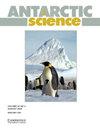新生代中晚期偏远南大西洋福克兰群岛上植物多样性雨林的证据
IF 2
4区 地球科学
Q3 ENVIRONMENTAL SCIENCES
引用次数: 0
摘要
我们报告了在福克兰群岛斯坦利附近发现的一个古林床,这是在南大西洋群岛上发现的第二个此类古沉积物,其特点是如今没有本地树种。保存在图萨克屋这一埋藏矿床中的化石花粉、孢子和木材碎片表明,该矿床的植被特征是植物多样的热带雨林,以Nothofagus-Podocarpaceae群落为主,类似于凉温带Nothofagus森林/林地和麦哲伦常绿Nothofagus热带雨林。该矿床的年龄界限是根据风、鸟类或洋流从巴塔哥尼亚南部迁移而来的化石花粉物种的地层分布,以及在更广泛地区观察到的类似植被类型推断出来的。据推测,该沉积层介于晚渐新世和早中新世之间,比之前分析的新近纪西点岛森林床(图萨克屋以西 200 公里处)略早。综合证据增加了我们目前对气候变化和植物繁殖体跨洋传播在古新世晚期和新近纪南半球高纬度生态系统形成过程中所起作用的了解。本文章由计算机程序翻译,如有差异,请以英文原文为准。
Evidence for a floristically diverse rainforest on the Falkland archipelago in the remote South Atlantic during the mid- to late Cenozoic
We report the discovery of an ancient forest bed near Stanley, on the Falkland Islands, the second such ancient deposit identified on the South Atlantic island archipelago that is today marked by the absence of native tree species. Fossil pollen, spores and wood fragments preserved in this buried deposit at Tussac House show that the source vegetation was characterized by a floristically diverse rainforest dominated by Nothofagus -Podocarpaceae communities, similar to cool temperate Nothofagus forests/woodlands and Magellanic evergreen Nothofagus rainforests. The age limit of the deposit is inferred from the stratigraphic distribution of fossil pollen species transported by wind, birds or ocean currents from southern Patagonia, as well as similar vegetation types observed across the broader region. The deposit is suggested to be between Late Oligocene and Early Miocene, making it slightly older than the previously analysed Neogene West Point Island forest bed (200 km west of Tussac House ). The combined evidence adds to our current knowledge of the role of climate change and transoceanic dispersal of plant propagules in shaping high-latitude ecosystems in the Southern Hemisphere during the late Palaeogene and Neogene.
求助全文
通过发布文献求助,成功后即可免费获取论文全文。
去求助
来源期刊

Antarctic Science
地学-地球科学综合
CiteScore
3.60
自引率
6.20%
发文量
42
审稿时长
3 months
期刊介绍:
Antarctic Science provides a truly international forum for the broad spread of studies that increasingly characterise scientific research in the Antarctic. Whilst emphasising interdisciplinary work, the journal publishes papers from environmental management to biodiversity, from volcanoes to icebergs, and from oceanography to the upper atmosphere. No other journal covers such a wide range of Antarctic scientific studies. The journal attracts papers from all countries currently undertaking Antarctic research. It publishes both review and data papers with no limits on length, two-page short notes on technical developments and recent discoveries, and book reviews. These, together with an editorial discussing broader aspects of science, provide a rich and varied mixture of items to interest researchers in all areas of science. There are no page charges, or charges for colour, to authors publishing in the Journal. One issue each year is normally devoted to a specific theme or papers from a major meeting.
 求助内容:
求助内容: 应助结果提醒方式:
应助结果提醒方式:


